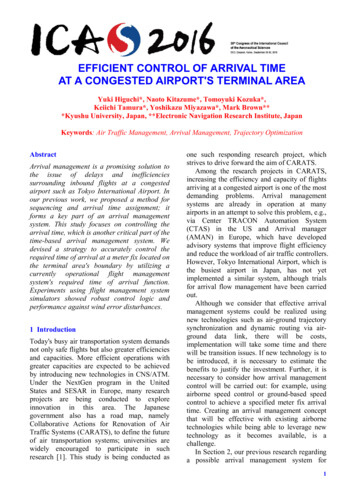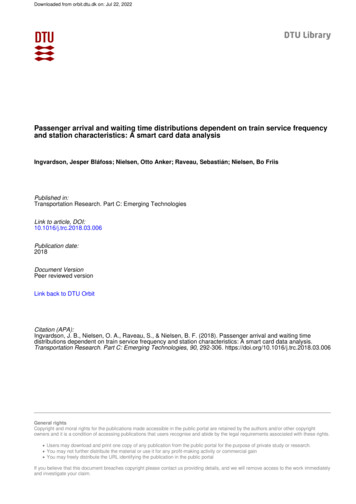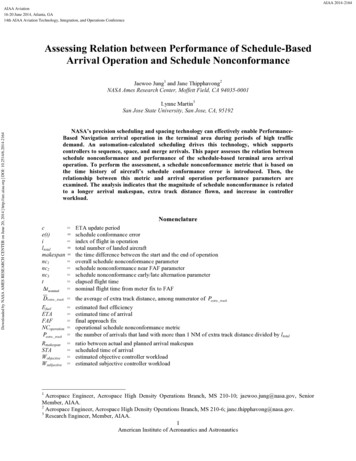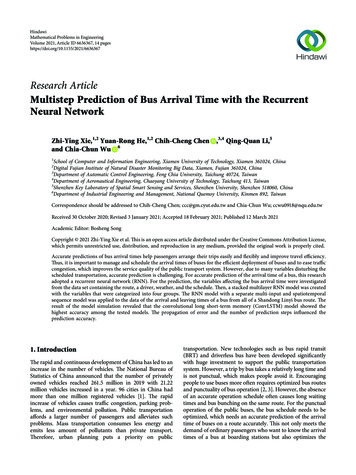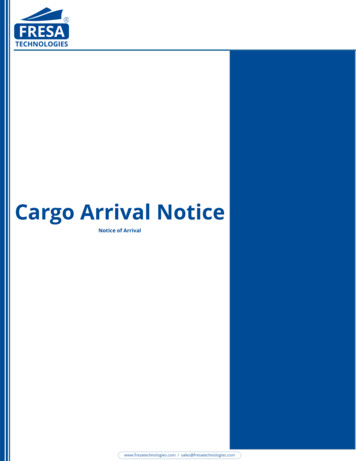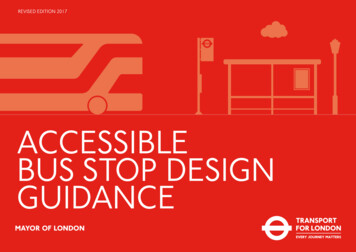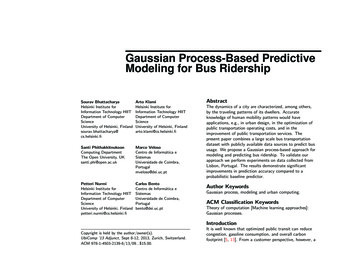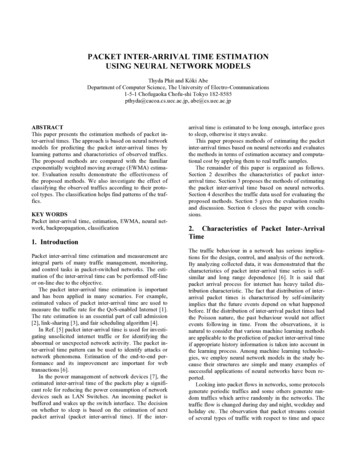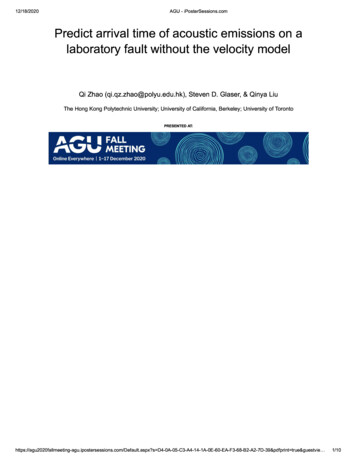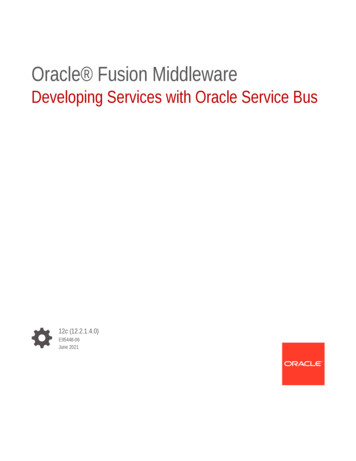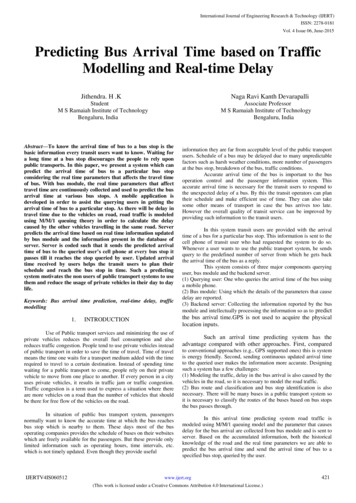
Transcription
International Journal of Engineering Research & Technology (IJERT)ISSN: 2278-0181Vol. 4 Issue 06, June-2015Predicting Bus Arrival Time based on TrafficModelling and Real-time DelayJithendra. H .KNaga Ravi Kanth DevarapalliStudentM S Ramaiah Institute of TechnologyBengaluru, IndiaAssociate ProfessorM S Ramaiah Institute of TechnologyBengaluru, IndiaAbstract—To know the arrival time of bus to a bus stop is thebasic information every transit users want to know. Waiting fora long time at a bus stop discourages the people to rely uponpublic transports. In this paper, we present a system which canpredict the arrival time of bus to a particular bus stopconsidering the real time parameters that affects the travel timeof bus. With bus module, the real time parameters that affecttravel time are continuously collected and used to predict the busarrival time at various bus stops. A mobile application isdeveloped in order to assist the querying users in getting thearrival time of bus to a particular stop. As there will be delay intravel time due to the vehicles on road, road traffic is modeledusing M/M/1 queuing theory in order to calculate the delaycaused by the other vehicles travelling in the same road. Serverpredicts the arrival time based on real time information updatedby bus module and the information present in the database ofserver. Server is coded such that it sends the predicted arrivaltime of bus to the queried user’s cell phone at every bus stop itpasses till it reaches the stop queried by user. Updated arrivaltime received by users helps the transit users to plan theirschedule and reach the bus stop in time. Such a predictingsystem motivates the non users of public transport systems to usethem and reduce the usage of private vehicles in their day to daylife.Keywords: Bus arrival time prediction, real-time delay, trafficmodelling1.In this system transit users are provided with the arrivaltime of a bus for a particular bus stop. This information is sent to thecell phone of transit user who had requested the system to do so.Whenever a user wants to use the public transport system, he sendsquery to the predefined number of server from which he gets backthe arrival time of the bus as a reply.This system consists of three major components queryinguser, bus module and the backend server.(1) Querying user: One who queries the arrival time of the bus usinga mobile phone.(2) Bus module: Using which the details of the parameters that causedelay are reported.(3) Backend server: Collecting the information reported by the busmodule and intellectually processing the information so as to predictthe bus arrival time.GPS is not used to acquire the physicallocation inputs.INTRODUCTIONUse of Public transport services and minimizing the use ofprivate vehicles reduces the overall fuel consumption and alsoreduces traffic congestion. People tend to use private vehicles insteadof public transport in order to save the time of travel. Time of travelmeans the time one waits for a transport medium added with the timerequired to travel to a certain destination. Instead of spending timewaiting for a public transport to come, people rely on their privatevehicle to move from one place to another. If every person in a cityuses private vehicles, it results in traffic jam or traffic congestion.Traffic congestion is a term used to express a situation where thereare more vehicles on a road than the number of vehicles that shouldbe there for free flow of the vehicles on the road.In situation of public bus transport system, passengersnormally want to know the accurate time at which the bus reachesbus stop which is nearby to them. These days most of the busoperating companies provides the schedule of buses on their websiteswhich are freely available for the passengers. But these provide onlylimited information such as operating hours, time intervals, etc.which is not timely updated. Even though they provide usefulIJERTV4IS060512information they are far from acceptable level of the public transportusers. Schedule of a bus may be delayed due to many unpredictablefactors such as harsh weather conditions, more number of passengersat the bus stop, breakdown of the bus, traffic conditions.Accurate arrival time of the bus is important to the busoperation control and the passenger information system. Thisaccurate arrival time is necessary for the transit users to respond tothe unexpected delay of a bus. By this the transit operators can plantheir schedule and make efficient use of time. They can also takesome other means of transport in case the bus arrives too late.However the overall quality of transit service can be improved byproviding such information to the transit users.Such an arrival time predicting system has theadvantage compared with other approaches. First, comparedto conventional approaches (e.g., GPS supported ones) this is systemis energy friendly. Second, sending continuous updated arrival timeto the queried user makes the information more accurate. Designingsuch a system has a few challenges:(1) Modeling the traffic, delay in the bus arrival is also caused by thevehicles in the road, so it is necessary to model the road traffic.(2) Bus route and classification and bus stop identification is alsonecessary. There will be many buses in a public transport system soit is necessary to classify the routes of the buses based on bus stopsthe bus passes through.In this arrival time predicting system road traffic ismodeled using M/M/1 queuing model and the parameter that causesdelay for the bus arrival are collected from bus module and is sent toserver. Based on the accumulated information, both the historicalknowledge of the road and the real time parameters we are able topredict the bus arrival time and send the arrival time of bus to aspecified bus stop, queried by the user.www.ijert.org(This work is licensed under a Creative Commons Attribution 4.0 International License.)421
International Journal of Engineering Research & Technology (IJERT)ISSN: 2278-0181Vol. 4 Issue 06, June-20152.RELATED WORKSMany scholars, researchers have put forward many ideas,theories and systems in order to predict the accurate arrival time ofbus. Intelligent transport systems (ITSs) are gaining recognition allover the world. Research has been going on all over the world fordeveloping an ITS which can predict the arrival time. Many systemsand prototypes are being developed. A system is also developed inwhich they have presented a bus arrival time prediction system basedon participatory sensing using cell tower sequence matching [1]. Inthis system they have used the mobile phones of transit users toapproximate the bus travelling routes and to predict bus arrival timeat the bus stops.Artificial neural network (ANN) model for predicting busarrival times was proposed [2]. ANN models require extensivetesting and training in order to find the right network structure anddetermine the best parameter values. Arrival time is predicted basedon the data accumulated by the GPS device mounted on the bus inorder to get the real time location of the bus [3].P2P overlay network was used in a arrival time predictionsystem [4]. Here they have proposed a method of combining a P2Poverlay network and WSN to develop a bus arrival time predictionsystem. In this a single WSN network was formed which consists ofa bus and a bus stop. In order to predict bus arrival time and transmitreal-time bus information, P2P overlay network was formed byconnecting all bus stations and bus terminals.Bus arrival time depends on many factors such as weatherconditions [7], number of travelers, traffic congestion etc. resulting,delay in the predefined schedule of the bus and inconvenience to thetravelers waiting at the bus stops. For a bus arrival time predictingsystem it is necessary to know the real time location of bus. Not onlythe location of bus helps in predicting time, but the total number oftravelers also helps in predicting the delay time of the bus. However,some of the information required to calculate the delay time has to besent to the server from the bus. In order to get the data required tocalculate delay the bus should be equipped with certain equipmentsbased on the data required by the server.The bus module contributes the information collectedwithin the module to the backend server as shown in Fig 1 (left side).Bus module consists of two components1. RFID reader2. Ticket machine3.1.2ServerServer is a software application that accepts the requestsfrom the clients and responds to the requests accordingly. Generallya backend server is the unit in a system which will be out of userinterface but handles the user input. Most of the computationcomplexity is shifted to the Backend server where the informationfrom all the modules in the system will be stored.A real time passenger information system (RTPIS) [5] wasdeveloped in which they have used tracking devices to get GPS dataof bus location and depict it in the approximate geographic positionson the route map. Main purpose of this system were to display thearrival time of bus at bus stops, web based interface for control roomto monitor buses in real time and mobile application for end users.Another Arrival time prediction model was proposed inwhich they have predicted the accurate arrival time of bus usingKalman filter model [6]. In order to predict the arrival time of bus toa particular bus stop, they have used the traffic information fromsocial networks updated by people who have witnessed events andupdated their social media accordingly. They have verified theresults with a corresponding SUMO simulation.3.SYSTEM OVERVIEWWe have developed an arriving time predicting systemwhich predicts the time for which the people at the bus stops has towait. The architecture of the system is shown in figure 1.This givesan account of the major components of the system design and howeach of the sections in the system works.The system mainly consists of three major components Querying user Bus module Backend server3.1Querying userQuerying user is the one who wants to get someinformation. In this system querying user is the one who wants toknow the accurate arrival time of the bus for a particular bus stop.The querying user uses his cell phone to send the query request to theserver by a message through GSM network.3.1.1Bus ModuleIJERTV4IS060512Fig 1. System architectureWe have developed a server in which the querying usergets the response as soon as the user sends the query to the server.The database of the server includes the road specifications and thebus stop details and the online processing part have the updater,delay calculator and the arrival time predictor in it. The GSMmodule of the server collects the query from the user and the datafrom the bus module and sends to the updater for the arrival timeprediction.4.TRAFFIC MODELLINGTraffic congestion of transport system is a phenomenon ofincreased disruption in traffic movement on a road. It is observedwhen number of vehicles approaches or exceeds the capacity of road.Traffic congestion depends on the arrival rate of vehicles, servicerate of the road, spacing between the vehicles, deviations from thewww.ijert.org(This work is licensed under a Creative Commons Attribution 4.0 International License.)422
International Journal of Engineering Research & Technology (IJERT)ISSN: 2278-0181Vol. 4 Issue 06, June-2015road and many more aspects add to congestion. Trafficcongestion is one of the main reasons that affects thecommute time of vehicles. So the modeling of traffic isimportant to calculate the time required by the vehicles toreach from one point to another.Simulation has been done for real situations usingthe traffic simulator, simulation in urban mobility (SUMO)which is capable of simulating real world road traffic usingdigital maps and realistic traffic models [8].M/M/1 queuing theory model is one of theapproaches that are used for traffic [modeling and it has beenused in many system designs and researches [9] [10] [11].4.1 M/M/1/α Queuing SystemM/M/1 queuing system refers to a system which hasnegative exponential arrivals and service times and a single server. Itis a better approximation for a large number of queuing systems.Since a single road is considered, this queuing theory suits theconsideration. For instance, a single link fed by a single transmitqueue qualifies as a single server and can be modeled as an M/M/1queuing system. Here:M Arrival or Departure distribution which is a Poisson process.1 Number of server (number of roads).5.1 Number of peoplePassenger is one of the important segments of a publictransport system. In this section we calculate the delay time based onnumber of passengers who get in and out of the bus.As soon as tickets are issued, the ticket issuing machineupdates the count of people who get in at a particular bus stop andget down at the upcoming stops. Based on this information the delaytime DN is calculated deterministically. The delay time DN refers totime delay caused by the passengers.DN N dDiscipline of a queuing system means the rule that serveruses to choose the next customer from queue when server completesthe service of current customer. Queue discipline used here is “firstin- first out” abbreviated as FIFO. This discipline serves onecustomer at a time.Performance parameters of M/M/1/α queuingsystemThe equations describing M/M/1 queuing system aresimple and easy to use.Where, N Number of peopled Average delay per personThis delay time is added to commute time to increase theaccuracy of prediction and this delay time (DN) and count of peopleis updated to the server from stop to stop as the people get in and outat every stop.Commute time refers to the time taken for a person tomove from one place to another. Whenever a vehicle moves fromone place to another, it has to move with some speed. This speed ofthe vehicle will not be same all through the distance, sometimes itmoves with more speed and sometimes in less speed (based on theroad conditions and other factors). So the average speed of vehicleneeds to be considered to predict the commute time of bus.By knowing the distance travelled by the vehicle and thetime consumed by it to travel that distance, it is possible to calculatethe average speed of the vehicle as follows:Performance measures [10]Average speed The average waiting time of a bus in the system ( W ) isgiven byW 1 1µ Service rate of the roadλ Arrival rate of the roadOnce arrival rate and service rate of the road is determined.The delay due to traffic in the system (road under consideration) iscalculated. As arrival rate will be updated from stop to stop theaccuracy of prediction also increases.To calculate commute time of the bus, current location ofbus is to be known. Once the location of bus is known, distance fromthe bus and destination bus stop can be calculated (based on thesurvey results which are done to calculate the distance between busstops). In order to know the location of bus and to predict the time,the update time of bus at one of the bus stop in the route it travels isconsidered.If querying user is at Q and the last or recent update wasfrom stop X, Assume that the bus has passed bus stop Q at time T,query has been received at time T1. Then:ARRIVAL TIME PREDICTIONIn this section, arrival time is predicted based on thediscussed theories in chapter 3 and other parameters that cause delayIJERTV4IS060512Distance travelledTime takenThe average speed for vehicles on that particular road will be fixed.[4].Where, W Waiting time of the vehicle5.25.2 Commute time4.1.1 Queue discipline4.1.1.1of the bus. The database, that is the information such as distancebetween the bus stops, Poisson arrival rate of each of the roadsincluding the roads that converge, service rate of main road (road atwhich the arrival time is to be predicted), average delay per person ingetting in and out of bus, average speed of vehicles is collected. Thisdata is necessary for backend server to calculate the arrival time.Parameters that influence the calculation of arrival time of bus arenumber of people, commute time, traffic congestion.time(t ) Distance between stop Q and XAverage speedwww.ijert.org(This work is licensed under a Creative Commons Attribution 4.0 International License.)423
International Journal of Engineering Research & Technology (IJERT)ISSN: 2278-0181Vol. 4 Issue 06, June-2015Commute time ( DC ) t (T T1 )6.Delay due to trafficDelay due to traffic is calculated based on the theorydiscussed above. From equation 1, average waiting time of a vehiclein a queue isW 1 M/M/1 queuing theory can be applied to the road traffic[11] in order to find the delay due to more number of vehicles in thequeue of the main road. W in M/M/1 queuing theory refers to thewaiting time of bus in queue which is the delay due to traffic.Delay due to traffic (DT) is givenDT 1n iRFID reader reads the tag (bus stop) details and ticketmachine gets the count of people at every bus stop. RFID reader,ticket machine and bus GSM module of the bus are controlled by amicrocontroller of the bus module. Whenever a bus reaches the busstop, real time information from the RFID reader and ticket machineis read by the microcontroller of bus module which is thenprocessed. Microprocessor prompts the GSM device of bus moduleto send processed data to GSM module of the server.Once the parameters necessary for calculating delay isreceived by the GSM module of server, microcontroller within theserver reads these data and displays them in the laptop. Updater unitof server updates these data within it and passes the data to delaycalculator which calculates the delay. Arrival time for the queriedbus stop is calculated based on this delay calculated. Themicrocontroller connected to server is then prompted to allow theGSM device of the server to send the predicted arrival time toqueried user by a text message through GSM network.7.1 Assumptions and considerations 3 i 0Where, n number of intersections. 6.1 Arrival timeArrival time of bus to the bus stop queried by user isdelayed due to traffic and the number of passengers as calculated inthe previous sections. Total delay time of a bus to reach the bus stoprequested by the querying user will be the sum of DN, DC and DT. Total delay time DN DC DTServer gets updated as soon as the bus reaches any bus stop(including people count).Bus travels in a fixed route. There are no divergingdeviations from the main route. Some other roads withdifferent Poisson arrival and service rates will join themain route.Single lane road is considered which means that vehiclescannot overtake other vehicle in a queue and one vehicle isserviced at a time. Figure 2 shows the queue system alongwith the service station.Interval for calculating Poisson arrival rate ( ) andservice rate ( ) is “1 minute” [10].Sum of Poisson arrival rates will be less than the servicerate of the main road.Bus travels in a pre-defined average speed all through thedistance.Arriving time of bus Queried time total delay timeThis arriving time is sent to queried user by a messagethrough GSM network. Since the arriving time is sent from stop tostop to queried user based on the changes in number of people andalso the Poisson rates, prediction time sent to the querying user willbe more accurate.7.SYSTEM IMPLEMENTATIONArrival time predicting system for a bus is designed using, Cell phone. Bus module-RFID reader, Ticket machine, GSM device,microcontroller. Server- Microcontroller, laptop, GSM device.Querying user sends the query request to server by amessage through GSM network. Server has a GSM module in it,which can receive data sent by querying user and the bus module.Data received by the GSM module of server is read by amicrocontroller. This microcontroller is connected to the laptopusing a USB to UART cable. Laptop displays the data received bymicrocontroller. Microcontroller is coded in such a way that everymessage received by the GSM module of server is read and updated.IJERTV4IS060512Fig 2. Queue system along with the service station7.2Mobile ApplicationMobile phone which we used here is an Android smartphone which is installed with a mobile application coded using javalanguage and developed under Android platform by using Eclipsetool. Screenshot of mobile application developed is shown in Fig3(a), (b). Purpose of using this application is to send queryingrequest to server in a format that could be understood by server andthe other thing is that by using a specified format of request,unwanted messages which are sent to servers by other people can befiltered out. The communication link between cell phone and serveris through AirTel GSM network.www.ijert.org(This work is licensed under a Creative Commons Attribution 4.0 International License.)424
International Journal of Engineering Research & Technology (IJERT)ISSN: 2278-0181Vol. 4 Issue 06, June-2015from the bus module is efficiently done by a Renesas 64 pin IC,whose brief operation is explained as follows.Backend server has database which is obtained by thesurvey of road and bus stops, updater, delay calculator and arrivaltime predictor. Survey data includes data such as bus stop IDs,Poisson arrival rate and Poisson service rate of the individual roads,total number of intersections of the roads to main road.Information received from bus module is updated in server.Once the querying user sends query request to server by specifyingthe bus stop, server fetches the data which was already stored inserver and calculates the delay time .This delay time is used tocalculate arrival time of bus to the bus stop specified by the queryinguser and sends this time to the user using GSM device of server.7.4.2Fig. 3. Screenshot of the mobile application7.3 Bus moduleBus module consists of the RFID reader, ticket machine,pre-processing unit and a GSM device.7.3.2RFID reader and tagRFID readers are generally used to detect the objectswhich have RFID tag in it. Here each of the bus stops is assignedwith a unique RFID tag. Whenever a bus approaches any bus stop,RFID reader is supposed to detect the bus stop (tag). For this purposeRFID reader is embedded into the bus module so that it can detectthe details of bus stop it passes by.Online processingOnline processing unit of server processes the real timedata that are available from bus module and information fromdatabase. Information that is sent to server is updated in updater unitof server. Screenshot of server in figure 4 shows the screen in whichthe count of people, last update time of bus, the query message aredisplayed and updated.As arrival time prediction includes the calculation of delaydue to traffic congestion, real time delay due to number ofpassengers, accuracy in the arrival time predicted will be more andcould be used for implementing in public transport systems.This reader collects the information of bus stop and passesto the pre-processing unit. Pre-processing unit converts the collecteddata to the format that could be understood by server. Theinformation of the bus stop will be collected automatically by RFIDreader without manual interpretation. The functionality of RFIDreader, GSM device is controlled by the microcontroller of the busmodule.Details about RFID reader used in project 125KHz frequency Passive readers and Tags Wireless distance range (3-5) cm7.3.3Figure 4 Screen shot of the online process8.Ticket machineAs soon as the passengers get into bus at each bus stop,tickets are issued to the passengers through a ticket vending machine.This ticket vending machine within bus module stores the count ofpeople who got into bus at that particular stop and who will get outof bus in the coming bus stops. Here in the implementation part, useof ticket machine is not done but the data that is supposed to be sentby ticket machine is assumed to have reached the server. This data isentered directly at the frontend of server as a user input.7.4Backend serverBackend server is implemented in Microsoft visual studiorunning on a Lenovo G500 laptop which has 2GB inbuilt RAM andINTEL CORE i3 processor. Dot net language has been used forcoding server. Functionality of the GSM device of server and busmodule, handling of incoming queries to server and incoming dataIJERTV4IS060512RESULTS AND CONCLUSIONServer responds to the queried user by text messages. GSMmodule of server sends the arrival time of bus to the queried user’scell phone. Along with sending the arrival time it also sends theupdated arrival time at every bus stop it reaches. This increases theaccuracy of prediction. Screenshot of updated arrival time receivedas text message by the queried user is shown in Fig.5.Arrival time predicting system has been designed whichconsiders real time parameters that causes delay such as number ofpeople and also results of traffic modeling. This system updates thearrival time of bus to queried user based on his query. It sends theupdated arrival time to user whenever bus reaches the bus stops ofpredefined route until bus reaches the stop queried by user.This system uses the location update of bus only when itreaches the bus stops of predefined route in order to predict thearrival time. But for higher accuracy of arrival time prediction it isnecessary to track the bus (location of bus) continuously all along theroute travelled by bus. Continuous tracking of bus helps to predictprécised arrival time of bus.www.ijert.org(This work is licensed under a Creative Commons Attribution 4.0 International License.)425
International Journal of Engineering Research & Technology (IJERT)ISSN: 2278-0181Vol. 4 Issue 06, June-20159.[1][2][3][4][5]Fig.5. Screenshot of the received arrival time of bus[6]Road transport services can use this system forimplementing in real time so that, updated arrival time received byusers helps the transit users to plan their schedule and reach the busstop in time. Such a predicting system also motivates the non usersof public transport systems to use them and reduce the use of privatevehicles in their day to day gfei Zhou, Yuanqing Zheng, Mo Li, “How long to wait?Predicting bus arrivaltime with mobile phone basedparticipatory sensing,” Proc of IEEE Transactions on mobilecomputing, vol. 13, no. 6, June 2014.Wei Hua tin, Robert L Bertini, "Modeling schedule recoveryprocesses in transit operations for bus arrival time prediction,"Proc. of IEEE 5th International Conference on IntelligentTransportation Systems, 2002, pp. 857-862.Jeong. R, L. R. Rilett, “Bus arrival time prediction usingartificial neural network model,” Proc. of IEEE IntelligentTransportation Systems Conference, Washington D.C, 2004,pp. 988–993.Ssu Hsuan Lu and Yu Wei Chan, “A prediction system usinga P2P overlay network for a bus arrival system,” Proc. ofHindawi publishing corporation journal of appliedmathematics, 2014.Swati Chandurkar, Sneha Mugade, Sanjana Sinha, MegharaniMisal, Pooja Borekar, “Implementation of real time busmonitoring and passenger information system,” Proc. ofInternational Journal of Scientific and Research Publications,Vol 3, Issue 5, May 2013.Ahmad Faisal Abidin, Mario Kolberg, “Towards improvedvehicle arrival prediction in public transportation: IntegratingSUMO and Kalman filter models,” Proc. of InternationalConference on Modeling and Simulation, 17th UKSIMAMSS, 2015.Ranjana Dinakar Raut, Vineet Kumar Goyal, “Publictransport Bus arrival time prediction with seasonal and specialemphasis on weather compensation changes using RNN,”Proc. of International Journal of Advanced Research inComputer and Communication Engineering, Vol. 1, August2012.Ahmad Faisal Abidin, Mario Kolberg, “Towards improvedvehicle arrival prediction in public transportation: IntegratingSUMO and Kalman filter models,” Proc. of InternationalConference on Modeling and Simulation, 17th UKSIMAMSS, 2015.Sony Sumaryo, A. Halim, K. Ramli. “Simulation and analysisof traffic flow models with emergency vehicles distortion ona single road,” Proc. of 2nd International Conference onTechnology, Informatics, Management, Engineering &Environment Bandung, Indonesia, August, 2014.Martin Anokye, A.R. Abdul-Aziz, Kwame Annin, Francis T.Odur, ”Application of queuing theory to vehicular traffic atsignalized intersection in Kumasi-Ashanti Region, Ghana,”Proc. of American International Journal of ContemporaryResearch Vol. 3 No. 7, July 2013.Fu-Yu Wang, Chun ming Ye, Yan Li, “Study on reasons andcountermeasures of traffic congestion of urban road based onthe queuing models,” Proc. of International Conference onComputational and Information Sciences, 2013.www.ijert.org(This work is licensed under a Creative Commons Attribution 4.0 International License.)426
Arrival time is predicted based on the data accumulated by the GPS device mounted on the bus in order to get the real time location of the bus [3]. P2P overlay network was used in a arrival time prediction system [4]. Here they have proposed a method of combining a P2P overlay network and WSN to develop a bus arrival time prediction system.

